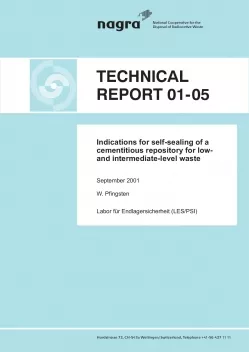
Technical Report NTB 01-05
Indications for self-sealing of a cementitious repository for lowand intermediate-level waste
Repositories for low and intermediate level nuclear waste contain large amounts of cementitious material. As a consequence of the interaction with formation waters, the cement will be degraded forming secondary minerals. The amount of precipitating secondary minerals depends on the chemical composition of the formation water. Furthermore, in the vicinity of the repository the hydraulic conditions and the parameters describing mass (radionuclide) transport will change with time during the cement degradation phase. As a result, porosity changes due to mineral and cement reactions will influence permeability and diffusivity: formation water rich in CO2 will lead to calcite precipitation in the water conducting zones surrounding the cementitious waste repository and, therefore, will have an impact on the radionuclide release from the cementitious repository into the host rock environment.
Laboratory column experiments showed concurrent porosity and permeability changes during degradation of porous cement discs. However, very different quantitative results have been observed when CO2-rich or pure water were used. The sequentially coupled flow, transport and chemical reaction code, MCOTAC, is used to include such observations in the modelling. A porosity-permeability and a porosity-diffusivity relation are used for describing cement degradation and related secondary mineral precipitation. For these complex coupled processes one-dimensional modelling has reached its limits of applicability. Therefore, two-dimensional model calculations are used to predict the temporal evolution of transport parameters for radionuclides within a “small scale” near-field of a cementitious waste repository. Mineral reactions influence hydraulic and transport parameters within such a near-field, causing reduced solute transport in the vicinity of the repository due to porosity and permeability changes at the rock-repository-interface. Also, the transport of radionuclides from the repository may be drastically reduced by porosity and permeability decreases. This is especially important for those radionuclides which show little or no sorption, since only the transport parameters (water flow velocity, dispersion and diffusion) will influence their migration behaviour. Within the “small scale” porous medium approach, coupling of chemical reactions and hydrodynamic parameters indicates a self sealing barrier at the host rock-repository interface for several scenarios. This barrier might persist for very long times and effectively contain radionuclides within the engineered repository system.
